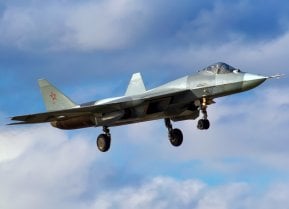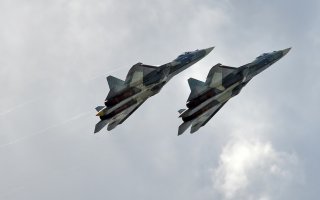Stealth Death Match: Russia's Su-57 vs. America's F-22 (Who Dies?)
If the two ever meet it will be a battle for the ages, but our world will be much worse for it.
Here's What You Need to Know: Both fighters are advanced designs that could win depending on how the battle unfolded.
Russia’s official designation of the PAK-FA/T-50 jet as the Sukhoi Su-57 is just another reminder that the field of fifth generation fighters is about to get more crowded. The United States, China, Russia, Japan and Korea are all working on their own fifth generation designs, but so far only three planes, the F-22 Raptor, F-35 Joint Strike Fighter and the Chinese J-20 are operational. Increased tensions between the United States and NATO on one side and Russia on the other have people wondering: once the Su-57 does become operational, how will it stack up against the F-22 Raptor?
The F-22 Raptor started life as a dedicated air superiority fighter in the same vein as the F-15C Eagle, the aircraft it was originally slated to replace. The aircraft was designed and built by Lockheed Martin, which had early experience building the first operational stealth warplane, the F-117A Nighthawk stealth “fighter”. In 1990, the prototype YF-22 fighter engaged in a flyoff with the Northrop YF-23 Black Widow II and won the competition, in large extent due to its emphasis on stealth and maneuverability.
Stealth was a foundational feature of the F-22, and the plane’s stealthy profile was in part dictated by simulations done on the Cray supercomputer, an early supercomputer. The F-22 design maximized sensor evasion, with diamond-shaped wings and sharp, faceted surfaces. The speed brake, weapon bay doors and engine exhausts are serrated to minimize the aircraft’s radar signature while the large, vertical, canted tails reduce the fighter’s infrared signature from certain angles. The aircraft’s metallic surfaces are also coated with radar-absorbent materials and paint.
The use of the Cray supercomputer helped make the F-22 highly maneuverable, especially at high angles of attack. A key F-22 feature is the use of thrust vectoring in the pitch axis, allowing the aircraft to combine engine power with maneuver at high angles of attack to gain an advantage in dogfights. The large bubble canopy was the largest single of piece of polycarbonate made while the F-22 was in production, and gave the pilot excellent visibility. The combination of maneuverability and visibility mean a pilot can detect and react to visual range threats quickly and decisively.
The F-22 is powered by a pair of F119 afterburning turbofan engines that produces a total 70,000 pounds of thrust, forty percent more than the F-15 Eagle. The engines allow the Raptor to supercruise at Mach 1.4 without afterburners, enhancing the aircraft’s range—an important consideration for a plane that can’t carry external fuel tanks into battle. The aircraft’s primary sensor, the AN/APG-77 radar, is designed to out-range enemy threats, detecting and classifying them before they detect the Raptor, allowing the American jet to not only see first, but shoot first.
The Raptor has three weapons bays, two of which can accommodate one AIM-9M/X Sidewinder infrared guided missile and a second belly bay that can accommodate six AIM-120 AMRAAM (“Slammer”) radar-guided missiles with a range of up to sixty-five miles. The center bay can also carry JDAM satellite-guided munitions or up to four 600 gallon fuel tanks. The F-22 has a M61A2 six-barreled, twenty-millimeter Gatling gun buried in the right wing root with enough ammunition for just under five seconds of sustained fire.
Much less is known about the Sukhoi Su-57. Despite seven years of test flights, many details about the aircraft remain unknown. What is known is that Sukhoi has struggled to develop the aircraft, particularly key components such as the engine. The first operational aircraft are slated to join the Russian Aerospace Forces in 2019.
Although both are fifth generation fighters, the Su-57 significantly differs in design philosophy from the F-22 Raptor. In the key areas of speed, maneuverability and stealth, the Raptor emphasized maneuverability and stealth. The Su-57, on the other hand, places an emphasis on maneuverability and speed, arguably making it similar to the YF-23 Black Widow II.
Experts believe the Su-57 is an evolution of the Su-27 Flanker’s shape, modernized for low radar observability but also even greater maneuverability. Aviation author Piotr Butowski claims that aircraft’s high static instability has “much more maneuverability at supersonic speeds than any previous fighter.” The blended wing design increases internal volume for avionics, fuel and weapons.
A major driver of the Su-57’s performance are its two engines. The Saturn izdeliye 30 engines are each meant to generate between 24,054 and 35,556 pounds of thrust, with the high end in the same territory as the F-22’s F119 engines. These are meant to drive the fighter to speeds of up to Mach 1.5 in supercruise. Unfortunately the izdeliye 30 is undergoing difficulties, and as a result the first twelve of Moscow’s new jets will be powered by a pair of Saturn AL-41F1 afterburning turbofans producing a combined 65,000 pounds of thrust, the same engines that power the Su-35.
The Su-57 will equip with the N056 Byelka (“squirrel”) radar system and the L402 electronic countermeasures suite. L-band arrays will be the fighter’s primary means of detecting stealth aircraft, while at shorter ranges the 101KS Atoll electro-optical suite, including an infrared search and track system, will help the pilot track and engage targets with infrared guided missiles.
The Su-57 has two large internal weapons bays arranged in tandem, taking up virtually the entire useable length of the aircraft. Each bay can carry up to four K-77M beyond visual range radar-guided missiles. Compared to earlier versions of the K-77 (NATO nickname: AA-12 Archer) the K-77M missile has a larger body and active electronically-scanned array radar seeker, allowing it to engage highly agile targets at ranges of up to 100 miles. The aircraft also stores a pair of K-74M2 short-range infrared guided missiles in underwing fairings.
How would the F-22 and Su-57 fare in a head to head engagement? The design priorities of the two aircraft give the two aircraft different advantages at different ranges. The Su-57’s priorities and armament lend themselves to detection and elimination of threats at long ranges. Key to this strategy, the Su-57’s radar must be able to detect stealth jets at long ranges. The aircraft’s emphasis on speed allows it to respond quickly—or back out quickly from fights it cannot win. Once the two opposing fighters close to visual range however the Su-57’s combination of maneuverability and infra-red search and track will make it a lethal opponent.
The F-22 Raptor, on the other hand, emphasizes stealth and maneuverability. The F-22 can also detect adversaries at long ranges, and provided it can evade enemy radar can act to set up an ambush before the enemy knows it is in the area. Thus the F-22 has more of a likelihood of gaining the initiative early on and winning the battle before the two jets can come within visual range of one another. Key to the Raptor’s strategy, the F-22’s stealth must protect it from the prying eyes of Russian radars. In a dogfight it’s difficult to know who would prevail, given we don’t know how maneuverable the Su-57 is, but the Russian jet’s infrared search and track system—something the American stealth fighter doesn’t have—will be a major bonus in combat.
The F-22 Raptor is an excellent, world-beating aircraft that sits on the very top of the heap. The Su-57 as a challenger could prove as good, in different ways, and a worthy opponent for the first fifth generation fighter to gain operational status. If the two ever meet it will be a battle for the ages, but our world will be much worse for it. Let’s hope all we ever get do is speculate about the meeting.
Kyle Mizokami is a defense and national security writer based in San Francisco who has appeared in the Diplomat, Foreign Policy, War is Boring and the Daily Beast. In 2009 he cofounded the defense and security blog Japan Security Watch. You can follow him on Twitter: @KyleMizokami.
This article first appeared in 2017.
Image: Wikimedia Commons


